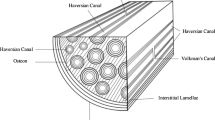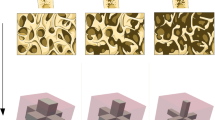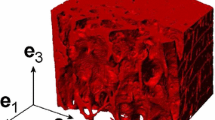Abstract
This paper considers the application of multiscale finite element method (FEM) to the modeling of cancellous bone as an alternative for Biot’s model, the main intention of which is to decrease the extent of the necessary laboratory tests. At the beginning, the paper gives a brief explanation of the multiscale concept and thereafter focuses on the modeling of the representative volume element and on the calculation of the effective material parameters, including an analysis of their change with respect to increasing porosity. The latter part of the paper concentrates on the macroscopic calculations, which is illustrated by the simulation of ultrasonic testing and a study of the attenuation dependency on material parameters and excitation frequency. The results endorse conclusions drawn from the experiments: increasing excitation frequency and material density cause increasing attenuation.
Similar content being viewed by others
References
Anderson CC, Marutyan KR, Holland M, Wear KA, Miller JG (2008) Interference between wave modes may contribute to the negative dispersion observed in cancellous bone. J Acoust Soc Am 124(3): 1781–1789
Ashman RB, Rho JY (1988) Elastic modulus of trabecular bone material. J Biomech 21(3): 979–986
Ashman RB, Corin JD, Buskirk WCV, Rice JC (1984) A continuous wave technique for the measurement of the elastic properties of cortical bone. J Biomech 17(5): 349–361
Ashman RB, Corin JD, Turner CH (1987) Elastic properties of cancellous bone: measurement by an ultrasonic technique. J Biomech 20(10): 979–986
Barkmann E, Kantorovich E, Singal C, Hans D, Genant H, Heller M, Gluer C (2000) A new method for quantitative ultrasound measurement at multiple skeletal sites. J Clin Densitom 3: 1–7
Bas PYL, Luppé F, Conoir JM, Franklin H (2004) N-shell cluster in watter: multiple scattering and splitting of resonances. J Acoust Soc Am 115(4): 1460–1467
Bathe KJ (1996) Finite element procedures. Prentice-Hall International, Englewood Cliffs
Batoz JL, Tahar MB (1982) Evaluation of new quadrilateral thin plate bending element. Int J Num Meth Eng 18: 1655–1677
Bauer AQ, Marutyan KR, Holland MR, Miller JG (2008) Negative dispersion in bone: the role of interference in measurements of the apparent phase velocity of two temporally overlapping signals. J Acoust Soc Am 123(4): 2407–2414
Bayraktar HH, Morgan EF, Niebur GL, Morris GE, Wong EK, Keaveny TM (2004) Comparison of the elastic and yield properties of human femoral trabecular and cortical bone tissue. J Biomech 37(1): 27–35
Biot MA (1956a) Theory of propagation of elastic waves in fluid-saturated porous solid. I. Low-frequency range. J Acoust Soc Am 28(2): 168–178
Biot MA (1956b) Theory of propagation of elastic waves in fluid-saturated porous solid. II. Higher frequency range. J Acoust Soc Am 28(2): 179–191
Bossy E, Talmant M, Laugier P (2004a) Three-dimensional simulations of ultrasonic axial transmission velocity measurement on cortical bone models. J Acoust Soc Am 115: 2314–2324
Bossy E, Talmant M, Laugier P (2004b) Bi-directional axial transmission can improve accuracy and precision of ultrasonic velocity measurement in cortical bone: a validation on test material. IEEE Trans Ultrason Ferroelectr Freq Control 51: 71–79
Bossy E, Padilla F, Peyrin F, Laugier P (2005) Three-dimensional simulation of ultrasound propagation through trabecular bone structures measured by synchrotron microtomography. Phys Med Biol 50: 5545–5556
Buchanan JL, Gilbert RP (2006) Determination of the parameters of cancellous bone using high frequency acoustic measurements. Math Comput Model 45(3–4): 281–308
Buchanan JL, Gilbert RP, Khashanah K (2002) Recovery of the poroelastic parameters of cancellous bone using low frequency acoustic interrogation. In: Wirgin A (ed) Acoustic, mechanics, and the related topics of mathematical analysis, World Scientific, pp 41–47
Buchanan JL, Gilbert RP, Khashanah K (2004) Determination of the parameters of cancellous bone using low frequency acoustic measurements. J Comput Acoust 12(2): 99–126
Droin P, Berger G, Laugier P (1998) Velocity dispersion of acoustic waves in cancellous bone. IEEE Trans Ultrason Ferroelectr Freq Control 45: 581–592
Fang M, Gilbert RP, Panachenko A, Vasilic A (2007) Homogenizing the time-harmonic acoustics of bone: the monophasic case. Math Comput Model 46: 331–340
Gilbert RP, Lin ZY, Hackl K (1998) Acoustic green function approximations. J Comput Acoust 6(4): 435–452
Hackl K (1997) A framework for nonlinear shells based on generalized stress and strain measures. Int J Solids Struct 34(13): 1609–1632
Hackl K (1998) Asymptotic methods in underwater acoustics. In: Florian K, Hackl K, Schnitzer F, Tutschke W (eds) Generalized analytic functions—theory and application to mechanics. Kluwer, Academic, , pp 229–240
Haïat G, Padilla F, Peyrin F, Laugier P (2007) Variation of ultrasonic parameters with microstructure and material properties of trabecular bone: A three-dimensional model simulation. J Bone Miner Res 22: 665–674
Haïat G, Lhémery A, Renaud F, Padilla F, Laugier P, Naili S (2008a) Velocity dispersion in trabecular bone: influence of multiple scattering and of absorption. J Acoust Soc Am 124(6): 4047–4058
Haïat G, Padilla F, Peyrin F, Laugier P (2008b) Fast wave ultrasonic propagation in trabecular bone: numerical study of the influence of porosity and structural anisotropy. J Acoust Soc Am 123(3): 1694–1705
Hall DE (1993) Basic acoustics. Krieger Publishing Company, Malabar Florida
Hazanov S, Amieur M (1995) On overall properties of elastic heterogeneous bodies smaller than representative volume. Int J Eng Sci 33(9): 1289–1301
Hildebrand T, Rüegsegger P (1997) Qualification of bone microarchitecture with the structure model index. Comp Meth Biomech Biomed Eng 1: 15–23
Hill R (1963) Elastic properties of reinforced solids: some theoretical principles. J Mech Phys Solids 11: 357–372
Hill R (1972) On constitutive macro-variables for heterogeneous solids at finite strain. Proc R Soc Lond A 326: 131–147
Hoffler CE, Moore KE, Kozloff K, Zysset PK, Brown MB, Goldstein SA (2000) Heterogeneity of bone lamellar-level elastic moduli. Bone 26: 603–609
Hollister SJ, Kikuchi N (1994) Homogenization theory and digital imaging: a basis for studying the mechanics and design principles of bone tissue. Biotechnol Bioeng 43(7): 586–596
Hosokawa A (2006) Ultrasonic pulse waves in cancellous bone analyzed by finite-difference time-domain methods. Ultrasonics 44: 227–231
Hosokawa A, Otani T (1997) Ultrasonic wave propagation in bovine cancellous bone. J Acoust Soc Am 101: 558–562
Hosokawa A, Otani T (1998) Acoustic anisotropy in bovine cancellous bone. J Acoust Soc Am 103: 2718–2722
Hughes ER, Leighton TG, Petley GW, White PR (1999) Ultrasonic propagation in cancellous bone: a new stratified model. Ultrasound Med Biol 25: 811–821
Ilic S (2008) Application of the multiscale FEM to the modeling of composite materials. Ph.D. Thesis, Ruhr University Bochum, Germany
Ilic S, Hackl K (2004) Homogenisation of random composites via the multiscale finite-element method. PAMM 4: 326–327
Ilic S, Hackl K (2007) Application of the multiscale fem to the modeling of heterogeneous materials. In: Proceedings of the first seminar on the mechanics of multifunctional materials, pp 47–51
Laugier P, Berger G, Giat P, Bonnin-Fayet P, Laval-Jeantet M (1994) Ultrasound attenuation imaging in the os calcis: an improved method. Ultrason Imaging 16: 65–76
Luo G, Kaufman JJ, Chiabrera A, Bianco B, Kinney JH, Haupt D, Ryaby JT, Siffert RS (1999) Computational methods for ultrasonic bone assessment. Ultrasound Med Biol 25: 823–830
Luppé F, Conoir JM, Franklin H (2002) Scattering by fluid cylinder in a porous medium: application to trabecular bone. J Acoust Soc Am 111(6): 2573–2582
Marsden JE, Hughes TJR (1983) Mathematical foundations of elasticity. Dover Publications, New York
McKelvie ML, Palmer SB (1991) The interaction of ultrasound with cancellous bone. Phys Med Biol 10: 1331–1340
Miehe C, Schotte J, Lambrecht M (2002) Homogenisation of inelastic solid materials at finite strains based on incremental minimization principles. J Mech Phys Solids 50: 2123–2167
Mura T (1993) Micromechanics: overall properties of heterogeneous solids. Kluwer, Dordrecht
Nemat-Nasser S, Hori M (1993) Micromechanics: overall properties of heterogeneous materials. Nord-Holland Series in: Applied Mathematics and Mechanics, vol 37
Nicholson PHF, Lowet G, Langton CM, Dequeker J, der Perre GV (1996) A comparison of time-domain and frequency domain approaches to ultrasonic velocity measurement in trabecular bone. Phys Med Biol 41: 2421–2435
Niebur GL, Feldstein MJ, Yuen JC, Chen TJ, Keaveny TM (2000) High-resolution finite element models with tissue strength asymmetry accurately predict failure of trabecular bone. J Biomech 33(12): 1575–1583
Ostoja-Starzewski M (2006) Material spatial randomness: from statistical to representative volume element. Probab Eng Mech 21(2): 112–132
Padilla F, Laugier P (2000) Phase and group velocities of fast and slow compressional waves in trabecular bone. J Acoust Soc Am 108: 1949–1952
Padilla F, Jenson F, Bousson V, Peyrin F, Laugier P (2008) Relationship of trabecular bone structure with quantitative ultrasound parameters: In vitro study of human proximal femur using transmission and backscatter measurements. Bone 42: 1193–1202
Pahr DH, Zysset PK (2008) Influence of boundary conditions on computed apparent elastic properties of cancellous bone. Biomech Model Mechanobiol 7: 463–476
Rho JY, Ashman RB, Turner CH (1993) Young’s modulus of trabecular and cortical bone material: Ultrasonic and microtensile measurements. J Biomech 26(2): 111–119
Rietbergen BV, Odgaard A, Kabel J, Huiskes R (1996) Direct mechanics assessment of elastic symmetries and properties of trabecular bone architecture. J Biomech 29(12): 1653–1657
Schröder J (2000) Homogenisierungsmethoden der nichtlinearen Kontinuumsmechanik unter Beachtung von Stabilitäts Problemen. Habilitationsshrift, Universität Stuttgart, Deutschland
Strelitzki R, Evans JA (1996) On the measurement of the velocity of ultrasound in the os calcis using short pulses. Eur J Ultrasound 4: 205–213
Taylor RL (1998) Finite element analysis of linear shell problems. In: Whiteman J (eds) The mathematics of finite element and applications, vol VI. Academic Press, London
Torquato S (2002) Random heterogeneous materials: microstructure and macroscopic properties. Springer Verlag, New York
Wanji C, Cheung YK (1997) Refined quadrilateral discrete kirchhoff thin plate bending element. Int J Num Meth Eng 40: 3937– 3953
Wear KA (2000) Measurement of phase velocity and group velocity in human calcaneus. Ultrasound Med Biol 26: 641–646
Williams JL, Johnson WJH (1989) Elastic constants of composites formed from pmma bone cement and anisotropic bovine tibial cancellous bone. J Biomech 22(6/7): 673–682
Willis JR (1981) Variational and related methods for the overall properties of composites. Adv Appl Mech 21: 1–78
Willis JR (1982) Elasticity theory of composites. Mechanics of Solids, the Rodney Hill 60th Anniversary Volume, pp 653–686
Zienkiewicz OC, Taylor RL (2000) The finite element method. Butterworth-Heinemann, London
Zohdi TI, Wriggers P (2005) Introduction to Computational Micromechanics. Springer Series in: Lecture notes in applied and computational mechanics, vol 20
Zysset P (2003) A review of morphology-elasticity relationships in human trabecular bone: theories and experiments. J Biomech 36: 1469–1485
Zysset PK, Guo XE, Hoffler CE, Moore KE, Goldstein SA (1999) Elastic modulus and hardness of cortical and trabecular bone lamellae measured by nanoindentation in the human femur. J Biomech 32: 1005–1012
Author information
Authors and Affiliations
Corresponding author
Rights and permissions
About this article
Cite this article
Ilic, S., Hackl, K. & Gilbert, R. Application of the multiscale FEM to the modeling of cancellous bone. Biomech Model Mechanobiol 9, 87–102 (2010). https://doi.org/10.1007/s10237-009-0161-6
Received:
Accepted:
Published:
Issue Date:
DOI: https://doi.org/10.1007/s10237-009-0161-6




